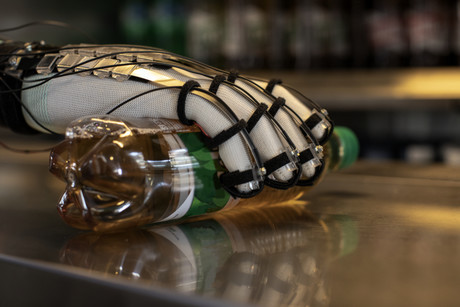'Touch' virtual objects with these ultralight gloves

Scientists from Switzerland’s EPFL and ETH Zurich have designed a haptic glove that provides extremely realistic feedback, enabling users to touch, grasp and manipulate virtual objects while feeling like they are actually touching something in the real world.
The hardware for the glove was developed by EPFL at its Microcity campus in Neuchâtel, while the virtual reality system was created by ETH Zurich, which also carried out the user tests. The result of their collaboration was an ultralight haptic glove, dubbed DextrES.
The glove is able to generate up to 40 newtons of holding force on each finger, with just 200 V and only a few milliwatts of power. It also has the potential to run on a very small battery. That, together with the glove’s low form factor (only 2 mm thick) and light weight (under 8 g per finger) translates into a high level of precision and freedom of movement.
“We wanted to develop a lightweight device that — unlike existing virtual-reality gloves — doesn’t require a bulky exoskeleton, pumps or very thick cables,” said Herbert Shea, Head of EPFL’s Soft Transducers Laboratory (LMTS).

DextrES is made of nylon with thin elastic metal strips running over the fingers. The strips are separated by a thin insulator. When the user’s fingers come into contact with a virtual object, the controller applies a voltage difference between the metal strips causing them to stick together via electrostatic attraction — this produces a braking force that blocks the finger’s or thumb’s movement. Once the voltage is removed, the metal strips glide smoothly and the user can once again move his fingers freely.
For now the glove is powered by a very thin electrical cable, but thanks to the low voltage and power required, a very small battery could eventually be used instead. “The system’s low power requirement is due to the fact that it doesn’t create a movement, but blocks one,” Shea explained.
The researchers also need to conduct tests to see just how closely they have to simulate real conditions to give users a realistic experience, with Otmar Hilliges, Head of the Advanced Interactive Technologies Lab at ETH Zurich, noting, “The human sensory system is highly developed and highly complex.
“We have many different kinds of receptors at a very high density in the joints of our fingers and embedded in the skin,” said Hilliges. “As a result, rendering realistic feedback when interacting with virtual objects is a very demanding problem and is currently unsolved. Our work goes one step in this direction, focusing particularly on kinesthetic feedback.”
The glove has already been successfully tested on volunteers in Zurich and was recently presented at the ACM Symposium on User Interface Software and Technology (UIST). The next step will be to scale up the device and apply it to other parts of the body using conductive fabric.
“Gamers are currently the biggest market, but there are many other potential applications — especially in health care, such as for training surgeons,” said Shea. “The technology could also be applied in augmented reality.”
Fingertip bandage brings texture to touchscreens
Researchers have developed a haptic device that enables wearers to feel virtual textures and...
Sweat sensor sticker monitors vitamin C in real time
Researchers have developed a battery-free electronic sticker designed to monitor vitamin C levels...
Flexible optical sensor detects pressure and location
Researchers have developed a multi-channel optical sensor that is capable of detecting both the...




